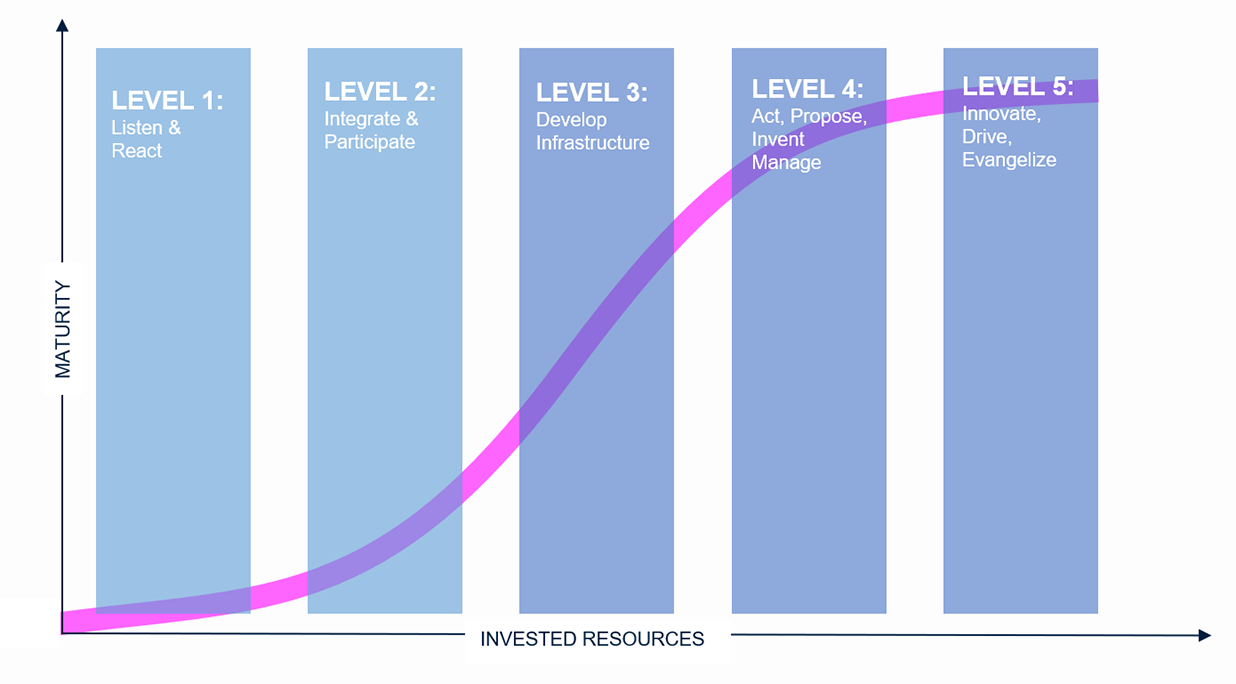Our Roadmap
Where are we going?
We’re working hard to improve how the VPFO connects internally with our teams and people, and externally with UBC and its community, in support of the mission and vision of our portfolio. As we move forward in this journey our communications will “mature” and enable us to truly excel in our work.
We developed this maturity model in the VPFO to explain the strategic roadmap for Communications & Engagement. Complex organizations like UBC can have units at any step in this model at any time. Our goal is to draw together the departments on the VPFO into a unified and integrated communications model with strong central and organizational support. This will drive better business outcomes and shift the culture of the organization to prioritize effective communications.

Identifying where you are on the maturity model
For each level, we’ve given an example of where you may typically see this level of communications maturity, but each step in the maturity model may exist in any part of an organization. However, as organizations become more mature they are less likely to spend long periods of time moving up the model. The first three levels are typically linked by being top-down and unit focused while the latter two levels show much more bi-directional (often multidirectional) flows of information and much higher transparency.
Maturity model levels
Top-down controlled communications: focused at individual department knowledge exchange and sharing
Level 1: typical of start-up culture
- Reliant on individual skill
- Little organizational support
- No objectives, reacting to emergent tasks
- No specific budget
- No measurement
Level 2: typical small business with flat organizational structures
- Localized Standards
- Similar projects can be successfully repeated
- Middle management involvement
- Operational objectives and tactics
- Redeployed budget
- Some teamwork
Level 3: typical of small-medium enterprise, likely with multiple revenue streams
- Organizational processes, policies, methodology, and standards
- Project management approach
- Senior Management involvement
- Strategic planning and stronger process
- Dedicated budget
- Group organization/learning
Bi-directional dynamic communications: organizational-wide with shared roles and high transparency
Level 4: typical of complex organizations
- Consistent outputs
- Integrated into Senior Management
- Specific strategy and process
- Dedicated budget
- Key Performance Indicators
- Responsibility and autonomy
Level 5: typical of complex organizations with high sense of mission
- Delivering organizational strategy
- Working methods are continuously improving
- High-levels of buy in
- Unified strategy with operations
- Project benchmarks, measurable results, process controls
- Dedicated budget
- Organizational project collaboration
Featured Resources
Model/Guide
Communications Maturity model
The Communications Maturity Model is our roadmap. The presentation gives more detail to each of the 5 levels of maturity
Did you find what you were looking for?
Thanks for your response! If you'd like to share further feedback, please take our survey.
Didn’t find what you were looking for? We’d like to hear from you! Share your thoughts by taking our survey.